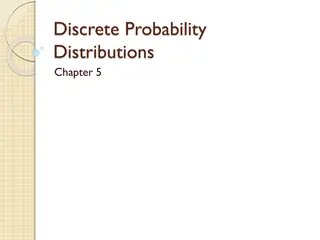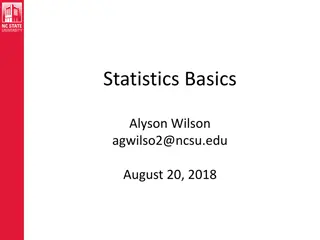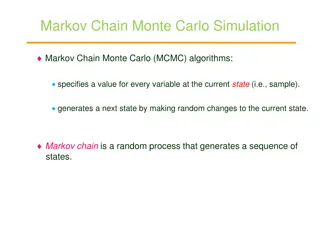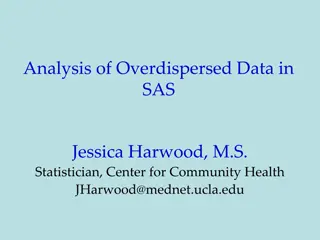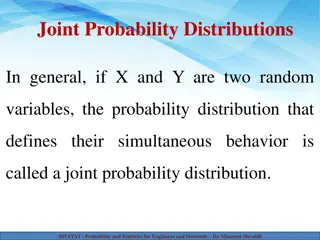Understanding Geometric and Poisson Probability Distributions
Explore the geometric and Poisson probability distributions, including criteria for geometric random variables, formulas, and practical examples. Learn how to calculate probabilities using the geometric distribution and apply it in scenarios like Russian Roulette and blood donor collection. Dive into the characteristics and applications of Poisson random variables to count the number of event occurrences in a given interval.
Download Presentation

Please find below an Image/Link to download the presentation.
The content on the website is provided AS IS for your information and personal use only. It may not be sold, licensed, or shared on other websites without obtaining consent from the author. Download presentation by click this link. If you encounter any issues during the download, it is possible that the publisher has removed the file from their server.
E N D
Presentation Transcript
PROBABILITY Section 4.3: MORE DISCRETE PROBABILITIY DISTRIBUTIONS
Objective: To be able to find probabilities based on geometric and Poisson distributions. Criteria for a Geometric Random Variable: 1. Each observation can be classified as a success or failure. 2. A trial is repeated until a success occurs. ***** 3. p is the probability of success and p is fixed. 4. The trials are independent. Ex. Russian Roulette
Geometrical Probability Formula: Let X be a geometric random variable and n be the number of trials until we obtain our first success. If X~G(p), then ? ? = ? = ?(? 1) ? Points regarding the geometric distribution: A geometric random variable is always discrete. To graph use a probability histogram. Every geometric probability distribution is skewed right. The geometric probability distribution is an infinite distribution in theory, but as n increases, the probability decreases. The smallest X can be is 1.
Ex. Given p = 0.75, find the probability that the first success occurs on the following trials: a. P(X = 1) b. P(X = 2) c. P(X = 3)
Calculator notation: For P(X = k) --- use geometpdf(p,X) For P(X k) --- use geometcdf(p,X) Using your calculator, find the probability that the first success occurs on the following trial: a. P(X = 4) b. P(X < 5) c. P(X < 3)
d. P(X < 4) e. P(X < 6) f. P(X > 4) g. P(X > 6) h. P(X > 5)
Suppose you work at a blood bank and are interested in collecting type A blood. It is known that 15% of the population is type A. Let X represent the number of donors until and including the first type A donor is found. a. Does this example meet the criteria for a geometric setting? b. Find probability that the first type A donor is the 4thdonor of the day. c. Find probability that the first type A donor is the 2nddonor of the day. d. Find probability that the first type A donor occurs before the 4thdonor of the day.
Criteria for a Poisson Random Variable: 1. X represents counting the number of times an event occurs in a given interval. The interval can be time, area, volume, 2. The probability of the event occurring is the same for each interval. 3. The number of occurrences in one interval is independent of the number of occurrences in other intervals. Poisson Probability Formula: The probability of exactly x occurrences in an interval is ? ? =??? ? ?! Where ? is the mean number of occurrences per interval unit.
The mean of a Poisson random variable is ?. So E[X] = ? Calculator notation: For P(X = k) --- use poissonpdf(p,X) For P(X k) --- use poissoncdf(p,X) Ex. The average number of absences per semester by a Probability student is 9. What is the probability that a student has 11 absences? b. Has 7 absences?
c. Has less than 7 absences? d. Has at most 7 absences? e. Has more than 10 absences? f. Has at least 12 absences?
Ex. Given that X has a Poisson distribution, with a mean of 2.4, find the following a. P(X=1) b. P(X=4) c. P(X < 4) d. P(X > 3)
e. P(X < 4) f. P(X > 5) Ex. Ten thousand brown trout are introduced into a small lake. The lake has a volume of 20,000 cubic meters. a. Find the average number of trout per cubic meter.
b. Find P(X=2) c. Find P(X = 1) d. Find P(X < 2) e. Find P(X > 1) f. Find P(X = 4)


